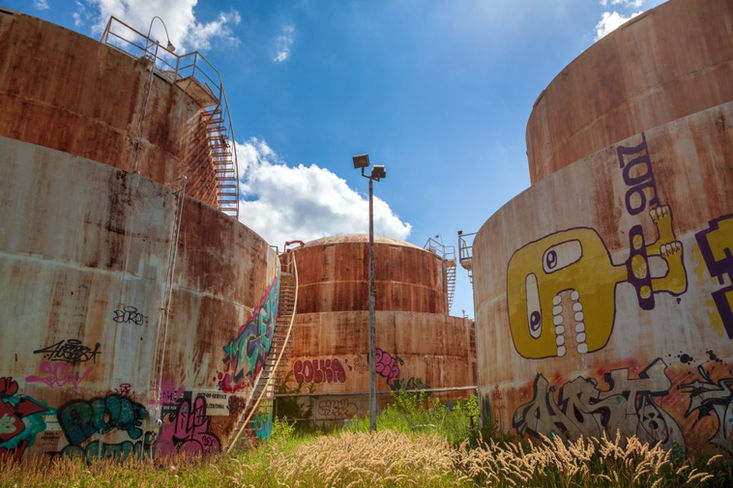The Tanks at Bushwick Inlet Park was a vision for an adaptive reuse park along the Williamsburg waterfront that would capture the creative ethos of the neighborhood around it—and reflect its rich history by breathing new life into the site’s industrial fabric.

What were the Tanks at Bushwick Inlet Park?
The Tanks at Bushwick Inlet Park was a proposal to breathe new life into ten decommissioned oil tanks on the Williamsburg waterfront, and incorporate them into the future Bushwick Inlet Park.
This vision captured the eclectic vibrancy of the neighborhood, and honors its rich industrial history. The Tanks were posed to achieve the acute community need for green open space while also serving as a dynamic, interactive and educational public space that unites a neighborhood. In building public support and awareness, the project has produced a series of events, including a design display of over 300+ attendees. The Tanks received a 2017 AIANY Design Award, AIANYS Award, Architizer A+ Popular Choice Award, and Architect’s Newspaper Best of Design Award.
In August 2019, the Tanks at Bushwick Inlet Park were demolished, but their concept lives on.
Where were they?
Williamsburg, Brooklyn. On the waterfront between Kent Avenue, North 12th Street, and the Bushwick Inlet.
The site for The Tanks is a seven-acre waterfront parcel that served as the historical home of one of Brooklyn’s most important industrial enterprises: Astral Oil Works, founded by businessman and philanthropist Charles Pratt. After decades of industrial decline, the site—which came to be known as the Bayside Fuel Terminal—became a hub for hundreds of artists, makers, and entrepreneurs, sitting at the very heart of Williamsburg’s thriving creative scene.
Besides its cultural and historical significance, the Bayside lot is overflowing with architectural character, including a three-story brick building with soaring ceilings and factory windows, and a series of 50-foot tall cylindrical, decommissioned fuel containers that rise from the ground to create a beautiful and other-worldly industrial topography.
What was the community response?
Over the course of four years, the Tanks team attended dozens of community meetings and produced four large-scale, free and publicized events to present our ideas to the community. These were held in local public gathering spaces and widely communicated to the larger neighborhood.
While every out-of-the-box project receives a range of feedback, we were excited by the wave of enthusiasm we got from the community. Hundreds of folks attended our events to interact with the idea, and we received over 1,000 signatures in less than two weeks on our Change.com petition to save the tanks.
Remedial Action Workplan (RAWP)
Our pro-bono expert team, led by Tenen Environmental, VHB, Thornton Tomasetti, and Arup, created a preliminary Remedial Action Workplan (RAWP).
The purpose of this RAWP was to address our collective primary concern: to realize a safe and successful park for Williamsburg/Greenpoint. In order to do this, a highly qualified group of environmental scientists, engineers, and counsel collaborated to prepare this report with the goal of proving that an environmentally-responsible public space can be created in a time- and cost-effective manner through adaptive reuse of the site’s industrial infrastructure and remediation-in-place.
The findings of this report are based on the extensive study and analysis of over 14,000 pages of documentation provided through Freedom of Information Law (FOIL) requests. The RAWP has been produced in collaboration with nine of New York City’s top environmental firms, who have collectively remediated and done work on hundreds of NYC waterfront sites.
We include a comparison of several remediation options, including those proposed by other stakeholders at various times, and their associated environmental impacts and costs, and conclude that our proposed strategy is safe, fast, less expensive as compared to alternative approaches.
You can view the entire RAWP here.









